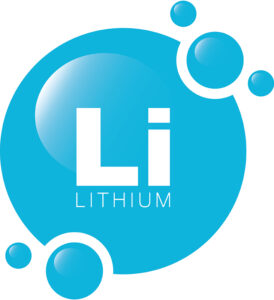By Eva Briggs, M.D.
I remember my first college chemistry class, taught by the amazing Dr. Benjamin P. Burtt at Syracuse University, who always performed captivating demonstrations.
One such demo involved dropping lithium into water, where it promptly burst into bright flames with a lot of smoke. More about Burtt can be found at www.syracuse.com/news/2012/03/ben_burtt_passionate_teacher_c.html

Fast forward about seven years and I learned in medical school about the use of lithium to treat bipolar disorder. For many people, it is an effective therapy to reduce episodes of mania and stabilize mood. It is relatively inexpensive. According to the GoodRx website, without insurance, 60 tablets of 300 mg lithium ER cost around $25.48 on average. I recall a patient — I’ll call him R — that I cared for more than 30 years ago. R had severe episodes of mania that kept him from working. He lived with his wife, who was just 14 when they married, and their four young children. They were very poor; living in what was essentially a shack in the northeast with no central heat or running water. When R was not medicated, he’d have manic episodes where he hardly slept. He became angry and irritable and had grandiose delusions. He once drove to Washington D.C. convinced that he could get a direct audience with then-president George H.W. Bush. He was sure Bush would help him with complaints he had about a former employer.
When R took his prescribed lithium, his energy levels returned to normal, his anger and irritability vanished and his thinking normalized. But he often couldn’t afford his lithium. Our office arranged a deal with the local pharmacy. The pharmacy would dispense R’s lithium to him at no charge and our office would quietly pay the cost.
On Aug. 6, 2025, the journal Nature published a study about the effect of lithium on the brain, leading to speculation that perhaps someday lithium will be an effective treatment for Alzheimer’s disease.
It’s been known that patients with Alzheimer’s accumulate a substance called amyloid beta in their brains. In this study, which spanned many years, researchers looked at strains of mice known to accumulate amyloid beta in their brains causing learning and behavioral changes. They also analyzed blood and brain samples from humans.
They found that amyloid beta deposits accumulated lithium, depleting it from brain structures. They looked at other metals, but no other metal was captured by the amyloid beta.
Administering supplemental lithium as lithium carbonate, the form used to treat bipolar disorder, did not reverse this brain tissue lithium loss. The amyloid beta was able to trap the lithium from lithium carbonate. But the researchers found that a compound called lithium orotate was able to deliver lithium to mouse brain cells, without being siphoned off by amyloid beta.
Lithium orotate reversed the changes resembling Alzheimer’s disease in mouse brains. It prevented cell damage and even restored memory. The dose was only about one thousandth of the amount needed to treat bipolar disorder with lithium carbonate.
Lithium carbonate has many potential serious side effects, such as kidney damage. Perhaps this lower dose of lithium will have fewer risks. But will lithium orotate even work in human Alzheimer’s patients? That of course will require further careful study to determine whether it’s safe and effective.
Another question arising from this study is whether measuring blood lipid levels will enable doctors to diagnose Alzheimer’s before symptoms emerge. Don’t try self-medicating with lithium at this time, though. It hasn’t been studied in human clinical trails, so we don’t know if it helps. And the widely available lithium carbonate (which requires a prescription) not only requires close medical monitoring for adverse effects, but it’s also not the form of lithium found beneficial in these early studies.
 Eva Briggs is a retired medical doctor who practiced in Central New York for several decades. She lives in Marcellus.
Eva Briggs is a retired medical doctor who practiced in Central New York for several decades. She lives in Marcellus.

